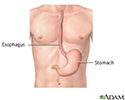Plummer-Vinson syndrome
Paterson-Kelly syndrome; Sideropenic dysphagia; Esophageal web
Plummer-Vinson syndrome is a condition that can occur in people with long-term (chronic) iron deficiency anemia. People with this condition have problems swallowing due to small, thin growths of tissue that partially block the upper food pipe (esophagus).
Causes
The cause of Plummer-Vinson syndrome is unknown. Genetic factors and a lack of certain nutrients (nutritional deficiencies) may play a role. It is a rare disorder that can be linked to cancers of the esophagus and throat. It is more common in women.
Symptoms
Symptoms may include:
- Difficulty swallowing
- Weakness
Exams and Tests
Your health care provider will do an exam to look for abnormal areas on your skin and nails.
You may have an upper GI series or upper endoscopy to look for abnormal tissue in the food pipe. You may have tests to look for anemia or iron deficiency.
Treatment
Taking iron supplements may improve the swallowing problems.
If supplements do not help, the web of tissue can be widened during upper endoscopy. This will allow you to swallow food normally.
Outlook (Prognosis)
People with this condition generally respond to treatment.
Possible Complications
Devices used to stretch the esophagus (dilators) may cause a tear. This can lead to bleeding.
Plummer-Vinson syndrome has been linked to esophageal cancer.
When to Contact a Medical Professional
Contact your provider if:
- Food gets stuck after you swallow it
- You have severe fatigue and weakness
Prevention
Getting enough iron in your diet may prevent this disorder.
References
Hammad H, Wani S. Esophageal tumors. In: Feldman M, Friedman LS, Brandt LJ, eds. Sleisenger and Fordtran's Gastrointestinal and Liver Disease. 11th ed. Philadelphia, PA: Elsevier; 2021:chap 48.
Kavitt RT, Vaezi MF. Diseases of the esophagus. In: Flint PW, Francis HW, Haughey BH, et al, eds. Cummings Otolaryngology: Head and Neck Surgery. 7th ed. Philadelphia, PA: Elsevier; 2021:chap 68.
Rustgi AK. Neoplasms of the esophagus and stomach. In: Goldman L, Schafer AI, eds. Goldman-Cecil Medicine. 26th ed. Philadelphia, PA: Elsevier; 2020:chap 183.
Review Date: 11/2/2022
Reviewed By: Michael M. Phillips, MD, Emeritus Professor of Medicine, The George Washington University School of Medicine, Washington, DC. Also reviewed by David C. Dugdale, MD, Medical Director, Brenda Conaway, Editorial Director, and the A.D.A.M. Editorial team.






